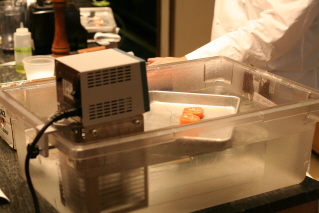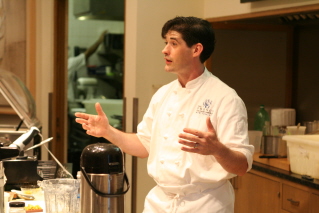Â
posted by Nastassia Lopez
 Dave and I met 6 months back on a 3-hour van ride with Cesare Casella, Mark Ladner, Alex Pilas and a salty bag of chicharrones pig skins from a Sunoco gas station in Jersey. Since then, I have watched his apartment oven preheat to 800 degrees while the rest of the house lights flickered and died, helped to pit his two sons against each other over the mechanical dissection of a bubblegum machine filled with numeric bouncy balls, and learned that there is only one way to chill glasses meant for alcoholic beverages – liquid nitrogen.
Dave and I met 6 months back on a 3-hour van ride with Cesare Casella, Mark Ladner, Alex Pilas and a salty bag of chicharrones pig skins from a Sunoco gas station in Jersey. Since then, I have watched his apartment oven preheat to 800 degrees while the rest of the house lights flickered and died, helped to pit his two sons against each other over the mechanical dissection of a bubblegum machine filled with numeric bouncy balls, and learned that there is only one way to chill glasses meant for alcoholic beverages – liquid nitrogen.
So when Dave asked if I might be interested in helping to write Cooking Issues, the only answer was yes.
I spent my first week with Nils and Dave measuring ABV, clarifying juice from upstate apples, learning how to defeather an entire chicken in one go, and breaking down an ancient duck press and putting it back together again
Yesterday, due to public demand, Nils gave a full demonstration of the three dishes he made on the July 15th episode of Top Chef Masters for FCI students: a Scallop Tartare with Smoke Potatoes Curried Apples and Chives; Slow Cooked Salmon with Napa Cabbage, Pureed Broccoli and Chorizo; and a Chocolate and Goat Cheese Ganache (the dessert that caused his tragic loss to Michael Chiarello).
Meanwhile Dave gave a plug to farmer’s market apples and got the audience buzzed with his Apple Saki and Rum carbonated cocktail.
Nils started first with the scallop tartare dish. He deglazed potatoes in white wine and chicken stock, blended it, added a spoonful of crème fraiche and two or three teaspoons of hickory smoked powder and blended again.

He then moved on to vacuum infuse/flash pickle the apples, which you can read about here. The vacuum essentially boils the liquids without any heat and sucks all the air out of the apples and uses the pressure of the returning air to inject the oil into the voids left by the vacated air. Like a million tiny syringes.  The apples started off floating on top of the oil. But the vacuum injection of oil caused them to sink to the bottom of the container by the end of the cycle.
Nils then sliced the scallops, and gave everyone a lesson on chives: Nils hates going to a restaurant and being served a full chive thread. As with garlic, the chive’s essence develops when it is cut.

The scallops were mixed with the chives, which were served on top of the potatoes and garnished with the apples.
The scallops took on the smoky flavor of the potatoes, and the slippery texture was nicely contrasted with the crunch of the pickled apples.

We then moved on to pressure cooking – a great technique for extracting flavor that is especially useful for making stocks and sauces. And because the boiling point is higher due to increased pressure, higher heat is generated inside the food, which breaks down any smelly compounds into less smelly ones. To which Dave made the joke “So if your girlfriend from Malaysia likes to cook her durian, you can get her a pressure cooker and you won’t have to deal with the stink anymore.â€
Nils infused milk with fennel and thyme and added the shaved florets and stem of broccoli. After boiling, he blended the mix straightaway, and spread it over a hotel pan to cool.
The stem of the Napa cabbage leaf was cut it into thin slices, and marinated with sugar, salt and vinegar. Once the fat was cooked out of the fresh chorizo the cabbage was added to the skillet.

According to Nils, nature can sometimes be an unfortunate thing when it comes to certain preparation. For example, the annoying decrease in size from the head of the fish to the tail, which creates the quandary of how to pump out 100 fish portions that are of equal size. Thank God (or – science) there is meat glue. Meat glue, or transglutaminase, is a natural enzyme that binds proteins together. It sprinkles on like powdered sugar. (Dave’s number one safety rule for meat glue, you ask? “Don’t SNORT IT!â€) Nils sprinkled the salmon with the meat glue and laid the other on top of it, head to tail.

He then rolled it extremely tightly in plastic wrap until it looked like a big salmon bat, and refrigerated it for 4 hours (the normal time it takes for fish to bind).

The salmon was then cut into medallions, placed on a small tray, and floated in a water bath set at 60 C for about 5 minutes.

Finally, the reduced Madeira that Dave distilled in his rotovap yesterday (turning it syrupy, and punchy without the “cooked†flavor) was spooned on the side of the salmon, providing an aesthetically beautiful contrast in colors from the fleshy oranges in the fish to the bright green of the broccoli puree.

Ultimately, the final result was a perfectly cooked salmon -slightly darker on the bottom, and rare and fleshy on top- with the cabbage and chorizo both balancing and complimenting the other.
Finally we moved on to the crux of Nils competition: the chocolate and goat cheese ganache. Â Goat cheese was combined with honey, cream and salt and the chocolate was melted in. The ganache was then spread and cooled on a sheet pan. It was delicious.
For the whipped cream, Nils had combined Lapsang tea and cold heavy cream in a vacuum bag and packaged it at full vacuum. He then let it infuse for 3 hours, strained it, added salt, and then whipped it, while adding simple syrup.
Dave asked the class what they thought of the cream. At first no one spoke up. Then Dave started yelling, and some brave souls meekly responded that they weren’t that crazy about it. But the room held mixed reviews. I liked the smoky flavors. Had I not known those flavors were coming from Lapsang, I may have liked it more – I felt like I was looking for it in every spoonful.
At this point, Nils had to make a quick exit. The Health Department was in the house.
Dave then took to the stage, in war protest style with, “Why should we care about apples? Because we live in the ass kicking apple center of the world!â€Â There should have been an uproar of support right then, but the students simply waited quietly for Dave to start mixing booze.

Dave had clarified juice from Pristine and Tydeman varietals of apples the day before (see enzyme clarification here) that he bought from two New York farmer’s markets. The clarification result of the Pristine was a softer green color, with a lighter more neutral taste. The Tydeman had a pinker hue and a sweeter taste. Either way, they were both brilliant.

They were both mixed with 10 Cane Rum and Kurosawa Sake, then carbonated. The apples and the sweetness of the rum blended insanely well, while the sake balanced the drink out – so that it wasn’t overpoweringly sweet. We still have until the end of November to keep juicing and clarifying the more than 1,000 varieties of apples that grow in New York State, so this cocktail has lots of room to metamorphosize.
After all of the fish and scallops and chocolate and apples that had been vacuumed and pressed, we were far from finished. When the room cleared (and the apple cocktail was finished off) Dave asked for his ducks. “Ducks? Now?†someone asked. “Yes, yes! Ducks now! Do it now!†Dave shouted in his fake Austrian accent.
And thus began my night with two chefs, two ducks and a deconstruction of a library duck press from the 1800’s, which I’ll save for next time.

You guys should open up the white balance on the camera. The food pics all look sepia-tone…
Sounds like a cool dish though!
Howdy Seth,
Noted. Fixed WB.
Where did you guys found those tiny Scallops shells?
i looked everywhere but cannot find them
thanks
We buy Taylor Bay scallops on the shell and save the shells, clean and boil them.
Haha! Looks good! That damn white balance…all you need is to fiddle with that and the macro focus and you can fire the “food stylist”…